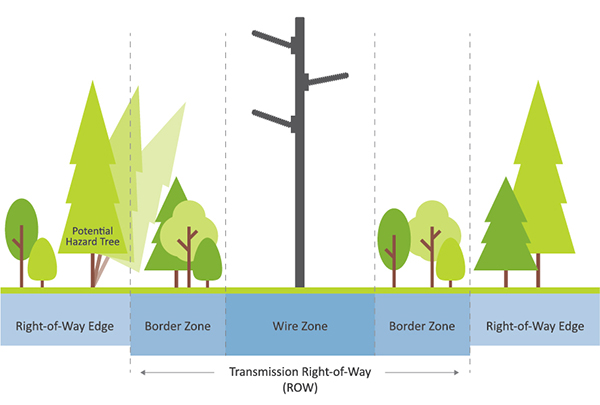Vegetation control methods used are influenced by environmental, location, seasonal, cost and landowner considerations, and comply with environmental legislation.
AltaLink has been accredited as a Right-of-way Stewardship Utility for Sustainable Integrated Vegetation Management since 2015. This accreditation recognizes AltaLink for committing to the Right-of-Way Stewardship Council’s stringent standards of excellence for the environmental management of the areas beneath transmission lines.
Industry standards
We follow industry standards for vegetation management, including guidance and research from:
- International Society of Arboriculture (ISA)
- Utility Arborist Association (UAA)
- Utility Vegetation Management Association (UVMA)
- Professional Vegetation Management Association (PVMA)
To help maintain our rights-of-way, AltaLink uses qualified and certified contractors to perform some vegetation management activities under our direction.
Vegetation management and easements
Vegetation management near our transmission lines includes removing or trimming danger trees, hazard trees, shrubs or undergrowth along the rights-of-way and Vegetation Control Easements (VCE).
A VCE is a strip of land on Crown land along the edge of right-of-way that allows AltaLink to remove hazard trees and danger trees.
A hazard tree is a defective tree that is an imminent risk of falling or flashover on the line, whereas a danger tree is a healthy tree that is tall enough to have the potential to fall and make contact with the line.

Compatible and non-compatible species
AltaLink has identified types of trees, shrubs and other plants that are safe to grow near our transmission lines (compatible) and those that are potentially dangerous to grow near our transmission lines (non-compatible).
This is not a complete list but is meant to generally illustrate the types of vegetation that are safe to be in or near our rights-of-way. Due to factors such as structure height, transmission line voltage, and width of right-of-way, safe heights for vegetation near transmission lines is determined on a case-by-case basis.
* Some varieties of willow, such as laurel leaf willow, are non-compatible for AltaLink’s transmission lines due to factors including how quickly they grow. Other varieties, such as wolf willow, may be considered compatible in specific areas. Willows are assessed on a case-by-case basis to ensure safety.
Weed control
AltaLink controls growth of weeds along our rights-of-way, which includes cutting, pulling or mowing, or the application of approved herbicides, depending on the area and its conditions, and the species of weed. On native grasslands, herbicides are not typically be used but, depending on the size and type of the infestation, may be the only option.
Weed control for rights-of-way on private land is generally the responsibility of the landowner. Sometimes AltaLink may have made commitments to monitor and control weeds for a specified period after construction projects have been completed. Please see AltaLink’s list of approved herbicides for use at our facilities. AltaLink only uses herbicides approved by Health Canada.
Grass mowing
We mow grass around our substations, telecommunications sites and along transmission lines through urban areas. We try to maintain these corridors with adjacent properties in mind, but please note these are industrial sites and will not be maintained to the same standard as a residential lawn. In some cases, they will be naturalized green spaces with taller grasses and low bushes. Transmission facilities within urban areas will typically be cut two to three times per year.